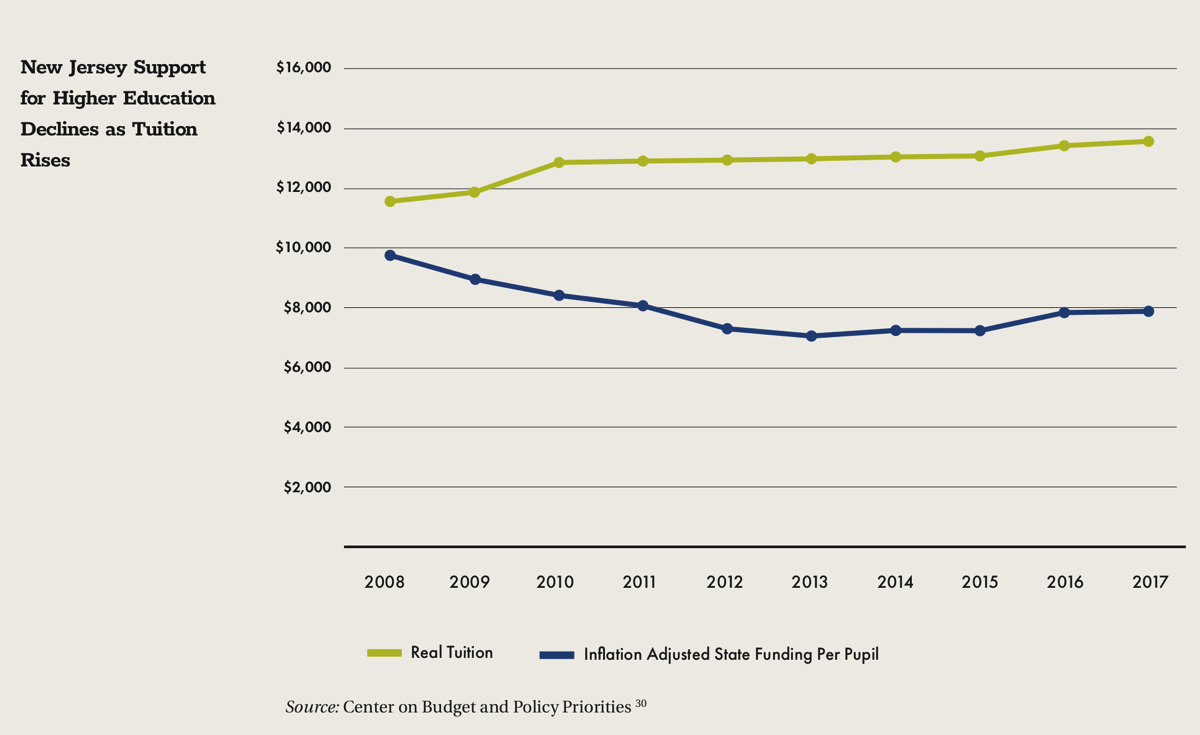Just as preschool provides a solid foundation for primary and secondary school learning, post-secondary education provides New Jersey’s workforce with the skills and training needed for the good jobs of the future. As the Crossroads NJ report “Promoting Jobs and Economic Growth for All New Jerseyans” noted, most jobs in New Jersey in 2020 will require some postsecondary education including two- and four-year college degrees.26 Although the state ranks among the top five states for the percentage of residents (50%) who have earned college degrees, New Jersey must generate about 30,000 new college graduates (with degrees from two- or four-year institutions) each year to meet the goal set by President Obama and the Lumina Foundation, that is, for 60% of U.S. residents to earn postsecondary degrees by 2025.27 In New Jersey, the Governor’s Council on Higher Education has set the goal at “65 in 25”—65% of New Jersey adults should attain a postsecondary degree or certificate by 2025.28
Access to post-secondary education has improved, and the number of first-year students entering two-and four-year colleges in New Jersey has increased significantly over the past 20 years. In 2016, 22,282 students began their studies at the state’s public four-year institutions, a 67% increase from the 13,328 students who began in 1996. Community colleges saw a similar rise in enrollment: 23,846 students entered in 2016, a 43% increase from 16,688 in 1996.29
At the same time, however, state investment in higher education has decreased by 21.3% per student (a decline per student from 2008 to 2017 of $2,113, adjusted for inflation).

With fewer public dollars supporting post-secondary institutions, students and their families have taken on a larger portion of the cost. Average tuition at the state’s four-year public colleges has increased 17.5% ($2,015 per student) since 2008.
Higher tuition leads to greater debt. In 2014, 69% of graduates from public four-year colleges in New Jersey had accumulated an average debt of $28,345 per student.31
Debt is even more of a problem for students who have college loans but do not complete degrees or certificates. They are left with the financial burden without the potential for increased future earnings or better jobs associated with degree completion. Even though New Jersey’s public four-year colleges outperform national averages, there is room for improvement in the state’s average six-year graduation rate of 62%.32 At the 19 two-year community colleges in New Jersey, 36% of students graduate within six years.33
New Jersey’s community colleges, with support from the statewide Student Success Center, are engaging in Guided Pathways, a national movement focused on increasing student success. Specifically, community colleges are: (1) partnering with local high schools to help students develop the academic skills needed to be successful in college so that students do not need to spend time and money on remedial coursework, (2) developing clearer pathways so that students know what courses they need to take in order to graduate with a degree or certificate and to ensure smooth transfer to four-year colleges, (3) providing professional development assistance for faculty so as to better support student learning, and (4) developing student support systems designed to help them to make good course selections and career decisions. As a result of these efforts,
New Jersey’s community colleges have increased the number of graduates to 23,577 in 2016, from 15,928 in 2008, a 48% increase.34 Yet, more must be done in order to help the state reach its “65 in 25” goal.
RECOMMENDATION
Invest in New Jersey’s two- and four-year colleges so as to expand the number of residents who earn degrees.
Implement and evaluate strategies to improve college completion rates.